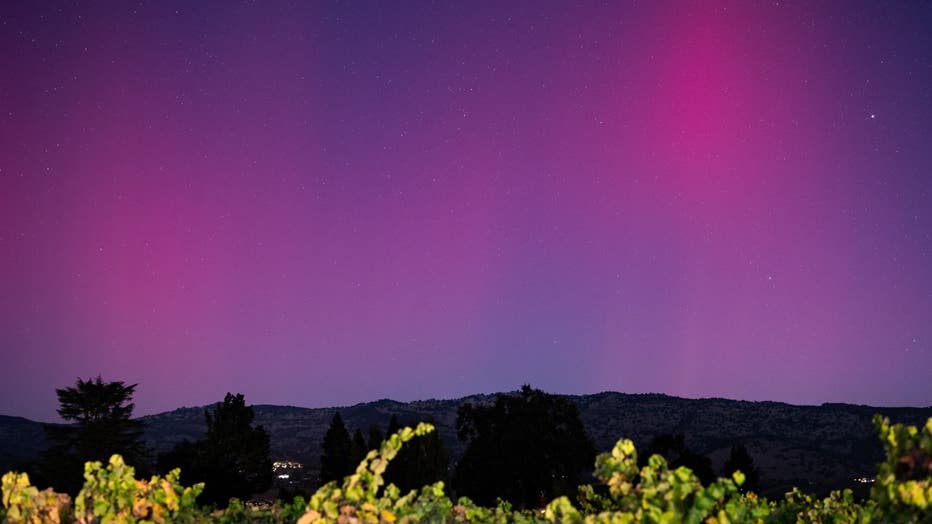Northern Lights visible in the Bay Area just north of Napa
Photo by Jaden Schaul.
ST HELENA, Calif. - It was a "total light show" in the North Bay on Thursday evening. A KTVU photographer captured an astronomical phenomenon known as a geomagnetic storm. The intense aurora produced by the storm is more commonly referred to as the Northern Lights.
Our photographer, Jaden Schaul, was set up near St. Helena where he captured amazing hues of blue and purple in the sky. He wrote on social media that the lights were visible to the naked eye. He posted photos as early as 7:30 p.m. About a half hour later, a photo was posted by someone else of the lights as seen from the Sierra Foothills. By 10 p.m. Schaul said the aurora was on "full display" from his vantage point. He posted a spectacular image of a brilliant purple sky with stars speckled throughout.
Northern Lights photos filled social media feeds with much of the content coming from the East Coast.

Photo of aurora borealis taken near St. Helena by Jaden Schaul.
The National Oceanic and Atmospheric Administration's (NOAA) Space Weather Prediction Center issued an alert saying the aurora may be visible at high latitudes, including the northern tier of the U.S., such as Michigan and Maine. That forecast was expanded to include parts of Northern California.
This expansion was because the solar coronal mass ejections (CMEs) passage intensified. This meant that conditions were favorable for the G4 level storm to continue into the night hours.
NOAA's geomagnetic storm scale goes from G1, minor, to G5, which is extreme. A G4 level storm is considered severe.
Events of solar coronal mass ejections (CMEs) send roughly a billion tons of plasma from the sun, with its embedded magnetic field, to Earth, according to NOAA.
When that solar material arrives at Earth, it can result in a geomagnetic storm.
NOAA says, "Aurora can often be observed somewhere on Earth from just after sunset or just before sunrise." The aurora is not visible during daylight hours.
The conditions in Napa were just right to take in the spectacle of the Aurora Borealis.
The aurora provides situational awareness for a number of technologies, NOAA says. That includes a direct impact on high-frequency radio communication and GPS satellite navigation because of the major disturbance in Earth's magnetic field.
NOAA has the scientific explanation for what's happening before your eyes here. They say the aurora typically forms 80 to 500 km above Earth's surface.
"During major geomagnetic storms these ovals expand away from the poles such that aurora can be seen over most of the United States. Aurora comes in several different shapes." When they refer to ovals, the aurora forms two ovals approximately centered at the magnetic poles.
NOAA says the G4 watch remains in effect for Oct. 11. For the latest, you can visit https://www.swpc.noaa.gov/
Previous reporting from KTVU's Sharon Song is included in this story.
Featured
Northern lights alert: Will the Bay Area be treated to a celestial show?
Strong geomagnetic storms are forecasted in the coming days, and that could bring spectacular northern lights displays to parts of the U.S.


